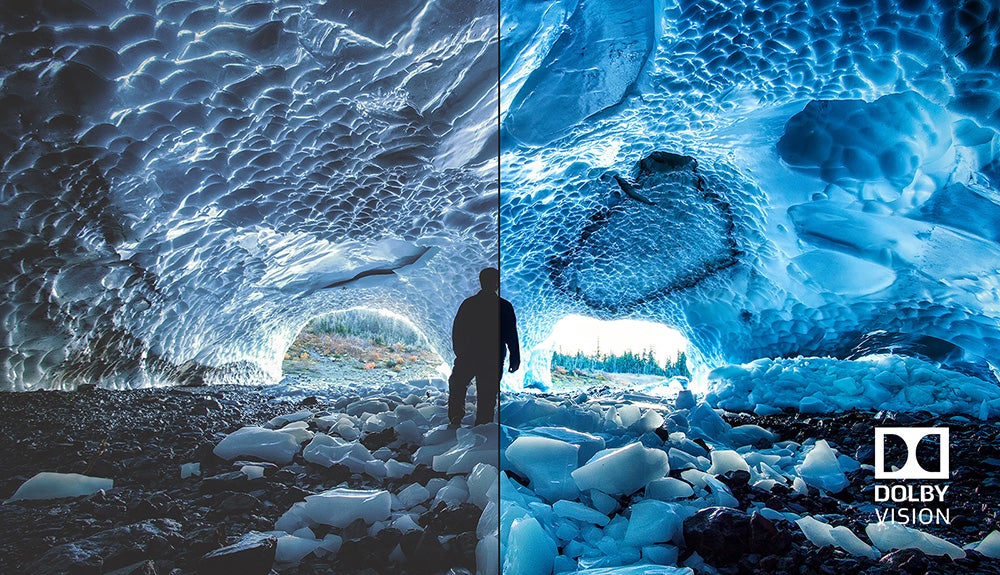Dolby Vision is a HDR format intended to deliver picture quality in the way the filmmaker or creator intended.
The big issue with picture quality on devices, whether on the best TVs or the best smartphones, is consistency. The variances in how HDR can look on displays that range from budget to premium means you’re not guaranteed a consistent HDR performance.
That’s where Dolby’s HDR tech steps in. It intends to deliver a more uniform, and consistent HDR performance in the way the creator intended.
We’ll explain how it works, who supports it, and whether your TV, game console, and mobile device need Dolby Vision.
What is Dolby Vision?

SDR (Standard Dynamic Range) displays can’t depict pure whites and deep blacks. HDR (High Dynamic Range) was created to improve picture quality by delivering greater contrasts for a more striking and natural picture. HDR10 is the standard HDR format that all devices must support.
Dolby Vision is an advanced HDR format that adds a layer of dynamic metadata on top of the HDR10 signal. That extra layer of metadata is what Dolby Vision uses to instruct the screen on how to display HDR content, and that data can be used to optimise the performance scene-by-scene or even frame-by-frame.
Dolby Vision versus HDR10
The main differences between the HDR10 and Dolby Vision is the latter’s use of dynamic metadata.
With HDR10, the metadata is static. It sets the luminance values (i.e., brightness) for the entire runtime. So, if you’re watching a TV show or film, the black level, and highlights (the brightest part of the image), remain the same throughout.


The problem with static metadata is that if a display can’t show the highlights or black levels as intended, then you can have issues with blacks being crushed (losing detail) or looking lifted (lacking depth). The brightest parts of the image can be affected by clipping (loss of detail).
Dolby Vision uses what’s called tone mapping to manage this problem, adjusting the colours, brightness, and black levels to match a display. HDR10 content can be tone mapped, but this is usually done by the TV itself, and not every brand tone maps in the same way which leads to differences in the image.
Dolby Vision masters of movies are done at 12-bit colour depth, rather than HDR10’s 10-bit. 12-bit depth can show a wider range of colours, as well as more shades of brightness and contrast.
Also, peak brightness with Dolby Vision can go up to 10,000 nits while HDR10 is 1000 nits. Most Dolby Vision masters target 4000 nits although there are outliers, such as Mad Max: Fury Road, which was mastered at 10,000 nits.


How do I turn on Dolby Vision
If you own a TV that supports Dolby Vision then it should, by default, automatically play any content in that HDR format.
Usually when programming supports both Dolby Vision and HDR10+, Dolby Vision is the preferred version.
With 4K Blu-ray players Dolby Vision can be turned on and off by heading into the picture settings of the player.
Who supports Dolby Vision?
Where TVs are concerned LG, Hisense, Panasonic, Philips, TCL, Toshiba, and Sony are some of the big TV brands that support Dolby Vision. It also appears on affordable sets where its help is arguably needed the most.
Premium laptops such as the Dell Inspiron 14 Plus along with the Microsoft Surface Pro 8 and Surface Laptop 7 carry Dolby Vision.
Apple supports it with its MacBook Air, Apple TV 4K, iPhones and iPads, while Microsoft also includes it for gaming on their Xbox Series consoles.
Other devices include Panasonic, Sony, Magnetar and Reavon 4K Blu-ray players. Dolby Vision is available on 4K Blu-ray and various (but not all) Amazon and Roku streaming devices.
It’s also supported across video streaming services with Apple TV+, Disney+, Netflix, Rakuten, Hulu, Paramount+, and more services carry the Dolby Vision badge.
Dolby Vision on mobile


Smartphones present content in Dolby Vision HDR for vivid HDR images on the go.
Dolby Vision on a mobile works similarly as it does on TVs, adjusting the performance of the display with richer, more vivid colours; and deeper blacks with better brightness.
The LG G6 was the first smartphone to adopt Dolby Vision, and Apple is fully on board with its iPhone series. The iPhone 12 series was the first to support capture (i.e., recording videos) and editing of footage on mobile devices in DV, and video site Vimeo also supports it on compatible Apple devices.
This is an area that’s continuing to grow, with newer iPhones offering ways to create content in Dolby Vision.
What is Dolby Vision IQ?


Dolby Vision IQ takes the dynamic metadata signal and uses the TV’s light sensor that measures the levels of ambient light in a room to adapt the image in response.
For example, watching Dolby Vision content in a bright room can lead to a reduction in detail and contrast. Dolby Vision IQ boosts brightness and ensures detail remains visible.
A more advanced version is Dolby Vision IQ with Precision Detail. It’s meant to improve levels of detail and sharpness. LG were the first to support with its TVs in 2022, and Panasonic TVs added it to some of its most recent TVs. It doesn’t appear to be called IQ with Precision Detail anymore, with the feature baked into the’regular’ Dolby Vision IQ version.
What about Dolby Vision Gaming?


Dolby Vision Gaming performs the same way as Dolby Vision does on other devices to make games look the best they can.
Support for 4K/120Hz is included, which allows for improved HDR performance at higher frame-rates (the speed at which images are displayed).
Right now, only Microsoft with its Xbox Series consoles supports Dolby Vision Gaming, with over 100 games available (including Halo: Infinite).
Bear in mind that just because a TV has Dolby Vision, doesn’t mean it necessary supports Dolby Vision Gaming. But more and more manufacturers have added a Dolby Vision Gaming mode to their TVs, such as LG, Panasonic, TCL, and Sony.
You can read more about Dolby Vision Gaming in our explainer, as well as about how to optimise your LG TV for gaming.
Does Dolby Vision deliver better picture quality?
Dolby Vision can deliver a superior viewing experience to HDR10 but it depends on the capability of your TV.
If, for instance, you have a TV capable of outputting above 1000 nits of peak brightness, there is less tone mapping for the TV to do. Arguably a HDR10 and Dolby Vision alongside each other would look very similar.
However, many films and TV series are mastered in Dolby Vision to deliver the exact performance that the creators wanted. And even with the best cheap TVs, Dolby Vision can produce better black levels and more accurate colours than HDR10 can. In fact, with TVs less capable of high brightness and deep black levels, that’s where Dolby Vision is needed most.
FAQs
Most seem willing to support Dolby Vision but the main holdout is Samsung. As one of the founders of the HDR10+ Alliance, Samsung sees no reason to support a rival HDR format.
And its philosophy of high brightness TVs – especially with its QLED range – means there’s less of a reason to use Dolby Vision’s tone mapping. HDR10 and HDR10+ are free for content creators to license. Those who wish to use Dolby Vision HDR must pay a licensing fee to Dolby, which could be another reason why Samsung doesn’t support Dolby Vision for its TVs.












